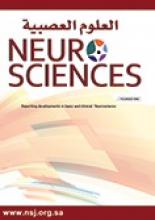A 4 year-old boy, born of consanguineous parents, with a normal birth, and developmental history. He was referred to our clinic with history of ataxia, and exhibited no signs of seizures, visual impairment, or cognitive decline. Physical examination revealed an ataxic gait, and normal cranial nerves. Ophthalmological examination of both eyes revealed healthy optic discs. On the electroretinogram, the ABC wave was present of deformed shape and small amplitude, suggestive of left side visual pathway (retinal) abnormality. Electroencephalogram showed no epileptiform discharges. T2-weighted brain magnetic resonance imaging (MRI) revealed multiple areas of white-matter hyper-intensity, as well as thalamic hypo-intensity (Figure1). Post-contrast axial T1 weighted imaging (Figure 2) showed smooth enhancement of the cranial nerves, and cauda equina. Whole-exome sequencing revealed a homozygous pathogenic variant in the CLN8 gene (c.709G>A, p.(Gly237Arg).
- Brain MRI. A) Axial FLAIR imaging shows hypointense thalami and hyperintense insular/sub-insular region and posterior limb of the internal capsule, B) hyper-intense periventricular and deep white matter. C) Coronal T2-weighted MR imaging shows mild cerebellar volume loss
- Brain MRI. A, B) Axial T1-weighted MR with contrast shows striking enhancement of the trigeminal and abducens nerves bilaterally. C) Coronal T1 C+ MPRAGE MR reformat shows enhancement of facial and trigeminal nerves. D) Sagittal T1 C+ Fat suppressed MR of the lumbar spine shows nerve root enhancement
The MRI appearance of abnormal cranial nerve enhancement in MRI can be seen in various diseases ranging from common infectious, demyelinating, neoplastic, and autoimmune diseases, to rare neurodegenerative diseases.1 Neuronal ceroid lipofuscinoses (NCL) are the most common neurodegenerative disorders of childhood that involve the accumulation of lysosomal storage material. Although imaging findings of CLN8 has not been extensively described, reports have shown similar features compared to other CLN subtypes with presence of T2/FLAIR hyperintensity in the periventricular and deep white matter, subinsular regions, and posterior limb of internal capsule; along with T2 hypointense thalami, cerebral and cerebellar atrophy. Cranial nerve enhancement in NCL however has not been described in literature to the best of our knowledge.2 Cranial nerve enhancement in CLN8 suggests secondary autoimmunity, and inflammatory response in the central nervous system, as described in the literature in a mouse model of NCL.3 The reason for cranial nerve enhancement in our case in unclear, and may suggest an inflammatory process, as has been described in a mouse model of NCL.
- Received August 22, 2021.
- Accepted December 1, 2021.
- Copyright: © Neurosciences
Neurosciences is an Open Access journal and articles published are distributed under the terms of the Creative Commons Attribution-NonCommercial License (CC BY-NC). Readers may copy, distribute, and display the work for non-commercial purposes with the proper citation of the original work.








